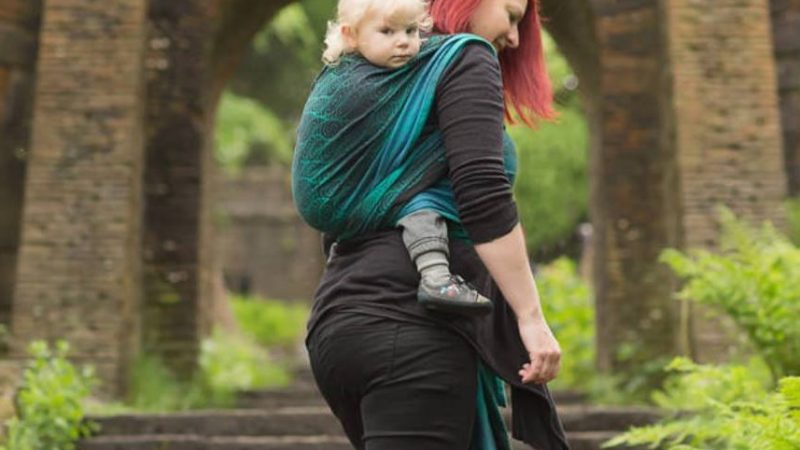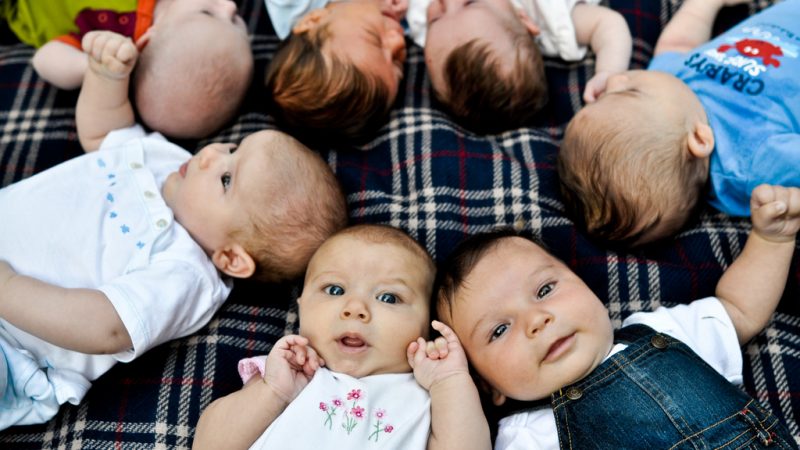
What do we know about babywearing? A Q&A with Dr Rosie Knowles
We were thrilled to talk to Dr Rosie Knowles this week. Rosie is a GP, founder of the Sheffield Sling Surgery, author of “Why Babywearing Matters” and experienced trainer of babywearing peer supporters.
Photo by Katrina Shepherd Photography
Q: Welcome everyone! And especially to Dr Rosie Knowles
Rosie: Hello!
PSG A: Welcome Rosie ?
Rosie: I’m actually in a layby on my phone after an ill-advised trip to Ikea with the kids after school!
PSG B: That’s heroic!
PSG D: Wow. Taking the kids to Ikea deserves a gin to get over the experience.
Q: Hi Rosie, I’m curious about the known effects of babywearing on a baby’s physiological state (heart-rate etc) – do we know anything about this?
Rosie: Oh yes quite a lot. There has been lots of research into the effects of skin to skin in the early neonatal period and also in premature babies. Skin-to-skin contact regulates heart rate, breathing, temperature as well as modulates the stress response.
As for the actual “use of a sling” as opposed to in arms or in a kangaroo care shirt, that’s less well defined. There are some studies done with mothers using soft slings for older children, but very little. There’s a general paucity of research specifically about slings per se. Lots about holding and touch etc.
PSG B: I guess with very premature/unwell babies, using a sling might be trickier than kangaroo care provided in shirt etc. But perhaps it’s not unreasonable to extrapolate?
Rosie: No it isn’t, but few very tiny premature infants even go in the kangaroo care shirts. They are usually just rested skin to skin inside a boob tube or under a light blanket and there is certainly no walking around with them.
Q: Is anything already known/proven about babies’ body temperature during baby wearing?
Rosie: That’s sort of the same question as the heart rate regulation. There is lots of evidence of skin-to-skin being a fantastic way to help manage a baby’s temperature. Babies can’t control their own temperatures very well at all.
Rosie: I think, if I recall correctly, it takes up to about 6 months for the thermoreceptors (located near the carotid) to really begin to work.
PSG C: Is that the artery that supplies the brain?
Rosie: Yes – you have two carotid arteries in your neck. They are the ones that you can feel pulsating either side of your neck. It’s one reason why scarves are very effective at warming people – your thermoregulators warm up and your whole body feels less cold. I have seen some experiments done with people in cold baths and warm things around their necks and not feeling the cold of the bath, but don’t quote me on that!
Being skin-to-skin with a carer is very effective at warming cold babies, and all the other benefits of skin-to-skin mean that it’s often more effective than an incubator (but the tubes make that very hard for the tinies).
Did you know that there is some suggestion that each side of a mother’s chest can modulate the temperature of two babies, differently?
PSG D: I did! But that’s possibly because I went to a seminar on kangaroo care.
Rosie: Kangaroo care babies and neonates are easy to study as they are dependent and being monitored anyway. It’s much harder to monitor older children in the same way. But it would be a great think to find out. I’d love to monitor oxygen saturations with proper paedeatric monitors e.g. a toe monitor, for different aged children in slings in different positions, and then collect the data and analyse it.
As for the use of slings and temperature; the main issues are more that of getting too warm. This is particularly pertinent with young babies and those who are carried in lots of layers in hospital environments.
I have yet to see a cold baby in a sling. I have seen many too-hot babies. And remember, they can’t sweat effectively to cool themselves down.
PSG D: I didn’t know that!
Rosie: The risk over overheating is significant.
PSG B: This isn’t a sling thing, but I remember my husband overheating our oldest child when he was a baby, by wrapping him in a giant blanket and then having him fall asleep on him. He was asleep for HOURS, and then we realised why – he was really (too) warm.
Rosie: Absolutely. There is this strongly embedded belief that babies need to be wrapped up warm. We only remove babies from snowsuits in slings in August! And there is a temptation to look at the thin sleeping bag/babygros and think that no way are they warm enough and so add a blanket. Plus the universality of central heating in many of our homes…..
Babies and mothers are adapted to each other’s bodies; and we are born hairless.
PSG E: How are you determining ‘too hot’?
Rosie: Too hot; that’s usually detected by the feel of their forehead and chest skin as well as markers of distress.
Part of the problem is that if too many layers separates baby from parent, the parent can’t feel the baby in the same way you would be able to feel a hot, sick child sleeping on your chest with very little on.
PSG A: On this topic, do fathers help with thermoregulation too? Is it to a lesser degree?
Rosie: Hmm I can’t remember but I don’t think its limited to mothers. No, because it’s all to do with receptors in the skin and cooling the skin down. I’m not sure if hairiness would attenuate that effect.
I *think* I can recall being told that mothers were significantly better than other adults, but that other adults were still significantly better than an incubator.
PSG A: Yes, that was my impression too, but I’m struggling to find any research to confirm it.
So if we were to conduct an experiment, ideally it would be with the same amount of layers between baby and parent, but also potentially the same sex parent too (to keep the samples the same)?
PSG F: So for the purposes of this experiment should we be looking at babies under 6 months, so before the thermoreceptors start working properly?
Rosie: Depends what you are wanting to achieve, but yes.
The greatest risk of death from suffocation (and overheating can also reduce the drive to breathe) is in the under-4 -months as they have heavy heads, whereas an older child would be able to hold their own head up and protest and struggle.
PSG C: We decided that we wanted to see how being in a sling affected a baby’s temperature compared to just playing on the floor. But there is an underlying desire to get a better idea about how likely it is that a baby could overheat in a sling. Clearly, we can’t set up an experiment with the aim of overheating a baby!
Rosie: You could monitor a temperature however. How would you do that? You’d need a consistent method of monitoring.
Also the type of sling matters e.g. three layers of thick stretchy wrap vs a thin linen ring sling or a thick Beco Gemini vs a solar Connecta
There is also the variable of whether child was brewing something and had low grade temperature.
And some people have higher resting core temps than others including adults.
PSG F: Regarding the age at which thermoreceptors start to work – how wide is the range of this in healthy children.? Are we talking a few weeks, months?
Rosie: I don’t know specifically re the age range
If you wanted another experiment to do, an awesome one would be to assess the effect of sling position on oxygenation! There have only been one or two studies into that. There are some suggestions that a sling reduces oxygen levels a tad, but not as much as a car seat. And no indication of what type of sling or position etc.
PSG F: Oooh, that would be fascinating!
Rosie: That’s what I’ve been wanting to do for ages if I ever had the facilities to do so. It would potentially really help with identifying if slings are a breathing risk especially cradle carries or loose and low carriers. But then of course you can’t do an experiment to see if a baby is at risk, so you would have to compare it to sleeping in a buggy/bed/car seat etc.
PSG D: We’ll have to ask Davide if they have a non-invasive O2 monitor for babies….
Rosie: You can get little toe stick-on ones. I have been so tempted to just borrow one from the children’s hospital. But they are not hard to get hold of online either.
Q: The incident that prompted this had a baby in a snow suit in a sling on a mild day.
When I trained as a babywearing educator we were told snowsuits were a big no-no for the same reason that they shouldn’t be worn in car seats (compression etc). Is that true?
Rosie: The main thing for car seats is that the air trapped inside snowsuits means babies are not properly restrained in the seat.
In both car seat and sling, air is an insulator, so the trapped air is going to raise temperature quickly. Plus with slings there is always the extra heat from parent, and from the padding plus the air. Furthermore, there is the issue that many snowsuits don’t fit, so babies sink down inside them and end up with faces buried in fur/down/minky and their airway is obstructed.
Snowsuits and slings are never a good mix unless they fit well, and are more like the super thin polar fleeces etc. All that fur near a small airway, all that bulk of the hood potentially tipping the occiput forwards, the heat, the reduced central drive to breathe.
Few parents are making deliberately wrong choices. There is so little information out there about so much baby equipment and so many things are made to appeal to the purse and the eye rather than thinking about safety aspects. “Oh that pretty snowsuit!” “Oh that harness sling that will mean my baby is close!” But also low, loose and hot as nobody mentions that in the instructions.
It’s often hard to change a parent’s mindset about keeping babies warm.
PSG C: How important do you think the temperature issue is? The TICKS guidelines (http://babyslingsafety.co.uk/) for safe babywearing are, I think, quite well known. Should they include an aspect about temperature, or is it of less importance?
Rosie: No, I think they should. I tend to use the American ABC ones more in teaching actually. The TICKS were absolutely vital as they were created in response to several suffocations in low and loose cradle slings, like bag and badly fitting pouch slings, so they are absolutely on point for ensuring safe airway.
They don’t mention the pelvic tuck which is also important, but not a direct safety aspect. Having said that, putting the pelvic tuck in actually protects the airway……
The American ABC is Airway, Body Position and Comfort – and temperature would come under comfort.
I think temperature needs to be discussed more – every few weeks I reshare my snowsuit in slings article – and it gets a lot of attention, but it’s mostly awareness in the non-sling community groups that need working on. Few people would go to a sling library and not have an idea about temperature,but you can buy a carrier from any website or parenting shop and it might not mention temperature.
In fact a lot of websites selling slings have NO INFORMATION ABOUT SAFETY directly and easily accessible at all. If they do it is often more than 2 clicks away. That’s not right.
Q: We have started discussing whether we want to limit our experiment to one type of, or maybe even specific, sling. If we did that, what type/brand/model would you think would be the best for us to use and why?
Rosie: Hmm that’s a very hard question. Because not every sling feels comfy for every parent/baby dyad, and they are all so different. For example, the padded Beco Gemini vs a Solar Connecta/Integra – both buckled carrier but utterly different in thickness.
Do you mean you would give people the same slings for the experiment and ask them to use that one only? if so then many people with newborns may opt for a stretchy wrap. but even then you would have to ensure it is tied right to be consistent
Also a crying baby makes a mother stressed and the stress response will often warm her body and her skin up. Plus the stress of putting on what seems a complex sling on can make people hot and bothered before they even start!!
PSG D: I guess in a ‘primary school – what variables are you controlling and what variables are you measuring?’ kind of way, we kind of have to decide if we are changing the clothing and keeping the slings and the position the same, or changing the sling and keeping the clothing the same, or only changing the position.
PSG C: Yes, we’d probably try and get a pile of identical slings and do the experiment using them. Stretchy wraps have been considered, but there is always the problem with the tie!
PSG C: And some kids really hate some slings. That could mess up the experiment, or make recruitment difficult if we have to say you can only come if your kid likes to be in sling x!
PSG D: Papoozle is soft and stretchy, done up the same way etc and I know the owner…
Rosie: In my experience, few newborns will resist a good stretchy tied right, assuming not breech or other birth trauma.
The papoozle is not easy to do well unfortunately. It lacks the effective third layer and parents struggle to get it tight enough. Even the close carrier needs a bit of help to do really well and is pretty hot as with the third layer it is actually 4 layers. if you used that then I would suggest the light version rather than the organic one.
Rosie: Have you got any professional sling folks working with you on choosing and fitting slings? Because the you could have someone teaching each parent how to use the sling on arrival so they could redo it consistently themselves.
PSG C: We’ve got a fair few peer supporters. I don’t really know the hierarchy of sling folk! Who can tell me?
Rosie: I don’t think it matters as long as the parents are all taught the same technique and are competent in its use – a good peer supporter would do that.
Consultants are more experienced and have more depth of training than peer supporters, but many peer supporters are brilliant at what they do if they have had lots of practice. Possibly more so than a very new consultant might be.
PSG C: Ok – that’s good then. I think we can be sure that we can get a volunteer or two without kids in tow who can be responsible for that.
Rosie: I’d make sure you have access to good follow-up instructions at home for the parents too and some online support so they can check they have got it right. I would also pick a “two way” stretchy wrap if you opt for that (simpler than the “one way” like the Moby).
We’re one step closer to our experiment on the temperature of infants during babywearing! If you’re inspired, why not read about our Q&A with Dr Davide Filingeri who came to talk to us about thermoregulation and measuring infants’ temperatures.


